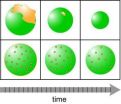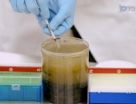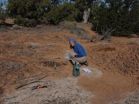(Press-News.org) DENVER – It is common for patients initially diagnosed with lung cancer to have the cancer spread to sites like the liver, brain and bone. One of the most frequent sites of metastases is the bone, with an estimated 30 to 40 percent of patients with non-small-cell lung cancer (NSCLC) developing bone loss. A study published in the December 2012 issue of the International Association for the Study of Lung Cancer's (IASLC) Journal of Thoracic Oncology, shows that the bone metastases drug denosumab was associated with improved overall survival compared with zoledonic acid (ZA).
A total of 811 lung cancer patients (411 for denosumab and 400 for ZA) were evaluated. Patients were randomized 1:1 to receive either monthly subcutaneous injection of denosumab 120 mg (plus intravenous infusion of placebo) or monthly intravenous infusion of ZA 4 mg (plus subcutaneous injection of placebo). The ZA dose was adjusted for renal impairment. And, daily calcium and vitamin D supple¬mentation was strongly recommended for all patients.
In all 811 lung cancer patients, denosumab was associated with significally improved overall median survival compared with ZA, with a difference of 1.2 month. In patients with NSCLC, denosumab was associated with significant improved survival, with a difference of 1.5 months.
In addition, overall survival in patients with small-cell lung cancer was 7.6 months for the deno-sumab group and 5.1 months for the ZA group, a difference of 2.5 months. Denosumab-treated patients with squamous cell carcinoma also showed improved survival compared with the ZA group, with a difference of 2.2 months. The treatments were associated with similar overall survival in patients with adenocarcinoma.
###
The lead author of this work is IASLC member Dr. Giorgio Scagliotti. Co-authors include IASLC members Dr. Vera Hirsch, Penella Woll, Dr. Christian Manegold, Dr. Maciej Krzakowski and Dr. Vladimir Kanarev.
About the IASLC:
The International Association for the Study of Lung Cancer (IASLC) is the only global organization dedicated to the study of lung cancer. Founded in 1974, the association's membership includes more than 3,500 lung cancer specialists in 80 countries. To learn more about IASLC please visit www.iaslc.org.
Study shows bone metastases treatment can improve overall survival
Researchers looked at denosumab versus zoledonic acid
2012-11-16
ELSE PRESS RELEASES FROM THIS DATE:
LLNL scientists assist in building detector to search for elusive dark matter material
2012-11-16
Lawrence Livermore National Laboratory researchers are making key contributions to a physics experiment that will look for one of nature's most elusive particles, "dark matter," using a tank nearly a mile underground beneath the Black Hills of South Dakota.
The Large Underground Xenon (LUX) experiment located at the Sanford Underground Research Facility in Lead, S.D. is the most sensitive detector of its kind to look for dark matter. Thought to comprise more than 80 percent of the mass of the universe, scientists believe dark matter could hold the key to answering some ...
Study: Cellphone bans associated with fewer urban accidents
2012-11-16
CHAMPAIGN, Ill. — Cellphones and driving go together like knives and juggling. But when cellphone use is banned, are drivers any safer?
It depends on where you're driving, a study by University of Illinois researchers says.
The study found that, long-term, enacting a cellphone ban was associated with a relative decrease in the accident rate in urban areas. However, in very rural areas, cellphone bans were associated with higher accident rates than would otherwise be expected.
"The main idea is to use the eye test when it comes to cellphone use," says study leader ...
Airborne particles smuggle pollutants to far reaches of globe
2012-11-16
RICHLAND, Wash. -- Pollution from fossil fuel burning and forest fires reaches all the way to the Arctic, even though it should decay long before it travels that far. Now, lab research can explain how pollution makes its lofty journey: rather than ride on the surface of airborne particles, pollutants snuggle inside, protected from the elements on the way. The results will help scientists improve atmospheric air-quality and pollution transport models.
The results also show that the particles that envelop pollutants also benefit from this arrangement. The new study in Environmental ...
Simplifying heart surgery with stretchable electronics devices
2012-11-16
Researchers at the McCormick School of Engineering are part of a team that has used stretchable electronics to create a multipurpose medical catheter that can both monitor heart functions and perform corrections on heart tissue during surgery.
The device marks the first time stretchable electronics have been applied to a surgical process known as cardiac ablation, a milestone that could lead to simpler surgeries for arrhythmia and other heart conditions. The researchers had previously demonstrated the concept to apply stretchable electronics to heart surgery, but with ...
Medical vital-sign monitoring reduced to the size of a postage stamp
2012-11-16
CORVALLIS, Ore. – Electrical engineers at Oregon State University have developed new technology to monitor medical vital signs, with sophisticated sensors so small and cheap they could fit onto a bandage, be manufactured in high volumes and cost less than a quarter.
A patent is being processed for the monitoring system and it's now ready for clinical trials, researchers say. When commercialized, it could be used as a disposable electronic sensor, with many potential applications due to its powerful performance, small size, and low cost.
Heart monitoring is one obvious ...
Video-article shows how to purify magnetic bacteria
2012-11-16
Magnetotactic bacteria, like Magnetospirillum magneticum, have evolved cellular processes that allow them to take up iron molecules to produce magnetic nanocrystals like magnetite. Since they were first discovered and isolated in 1975 by Robert Blakemore, scientists continue to be fascinated by these unique bacteria, whether as a means to isolate biogenic magnetite or to understand the evolutionary advantages of producing these minerals. A new video-article in JoVE (Journal of Visualized Experiments) details a procedure to purify and enrich samples of magnetotactic bacteria ...
Researchers report potential new treatment to stop Alzheimer's disease
2012-11-16
Last March, researchers at UCLA reported the development of a molecular compound called CLR01 that prevented toxic proteins associated with Parkinson's disease from binding together and killing the brain's neurons.
Building on those findings, they have now turned their attention to Alzheimer's disease, which is thought to be caused by a similar toxic aggregation or clumping, but with different proteins, especially amyloid-beta and tau.
And what they've found is encouraging. Using the same compound, which they've dubbed a "molecular tweezer," in a living mouse model ...
WSU scientists find new way for antibiotic resistance to spread
2012-11-16
PULLMAN, Wash.—Washington State University researchers have found an unlikely recipe for antibiotic resistant bacteria: Mix cow dung and soil, and add urine infused with metabolized antibiotic. The urine will kill off normal E. coli in the dung-soil mixture. But antibiotic-resistant E. coli will survive in the soil to recolonize in a cow's gut through pasture, forage or bedding.
"I was surprised at how well this works, but it was not a surprise that it could be happening," says Doug Call, a molecular epidemiologist in WSU's Paul G. Allen School for Global Animal Health. ...
Young gamers offer insight to teaching new physicians robotic surgery
2012-11-16
What can high school and college-age video game enthusiasts teach young surgeons-in-training?
According to a new study from researchers at the University of Texas Medical Branch at Galveston (UTMB) – a world leader in minimally invasive and robotic surgery – the superior hand-eye coordination and hand skills gained from hours of repetitive joystick maneuvers mimic the abilities needed to perform today's most technologically-advanced robotic surgeries.
To offer insight on how best to train future surgeons, the study placed high school and college students head to head ...
Degraded military lands to get ecological boost from CU-led effort
2012-11-16
Some arid lands in the American West degraded by military exercises that date back to General George Patton's Word War II maneuvers in the Mojave Desert should get a boost from an innovative research project led by the University of Colorado Boulder.
Headed up by CU-Boulder Assistant Professor Nichole Barger, the research team is focused on developing methods to restore biological soil crusts -- microbial communities primarily concentrated on soil surfaces critical to decreasing erosion and increasing water retention and soil fertility. Such biological soil crusts, known ...
LAST 30 PRESS RELEASES:
Nationally renowned anesthesiology physician-scientist and clinical operations leader David Mintz, MD, PhD, named Chair of the Department of Anesthesiology at the UM School of Medicine
Clean water access improves child health in Mozambique, study shows
Study implicates enzyme in neurodegenerative conditions
Tufts professor named Fellow of the National Academy of Inventors
Tiny new device could enable giant future quantum computers
Tracing a path through photosynthesis to food security
First patient in Arizona treated with new immune-cell therapy at HonorHealth Research Institute
Studies investigate how AI can aid clinicians in analyzing medical images
Researchers pitch strategies to identify potential fraudulent participants in online qualitative research
Sweeping study shows similar genetic factors underlie multiple psychiatric disorders
How extreme weather events affect agricultural trade between US states
Smallholder farms maintain strong pollinator diversity – even when far from forests
Price of a bot army revealed across hundreds of online platforms worldwide – from TikTok to Amazon
Warblers borrow color-related genes from evolutionary neighbors, study finds
Heat signaling from plants is an ancient pollinator signal
New index reveals the economics underlying the online manipulation economy
High-resolution satellite observations reveal facility-level methane emissions worldwide
Researchers discover how Ebola and Marburg disrupt the gastrointestinal tract
Feeling the heat
Eastward earthquake rupture progression along the Main Marmara Fault towards Istanbul
Scientists uncover how Earth’s mantle locked away vast water in early magma ocean
Scientists uncover key driver of treatment-resistant cancer
Rare image of Tatooine-like planet is closest to its twin stars yet
Music: Popular song lyrics have become more negative since 1973
Marine ecology: Killer whales tail dolphins to hunt salmon
ADHD prescriptions on the rise, study finds
How to build a genome
Sharp rise in ADHD stimulant prescriptions in Ontario, research finds
Trends and prevalence of the metabolic syndrome among US adults
Population-level trends in ADHD medication prescribing
[Press-News.org] Study shows bone metastases treatment can improve overall survivalResearchers looked at denosumab versus zoledonic acid


